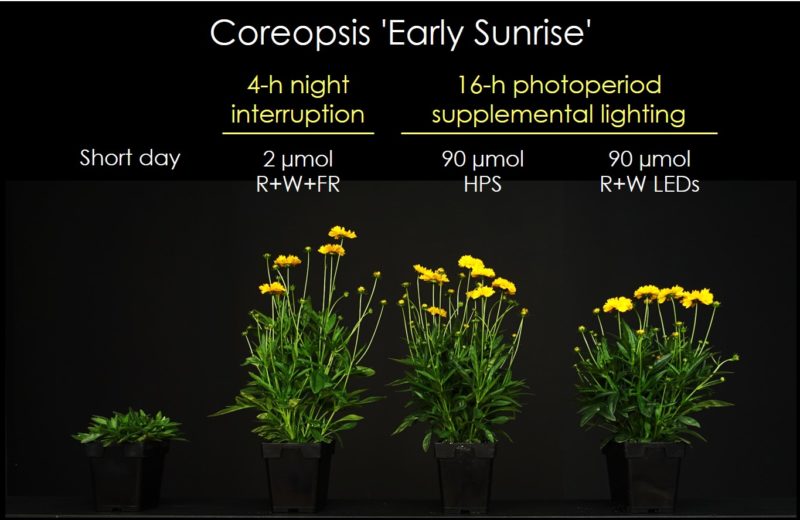Height Control of Perennials: What Works and What Doesn’t
Containerized herbaceous perennials are commonly produced in flower for spring and summer sales. While some plants require a cold treatment to induce flowering, others primarily flower in response to day length.
Regardless of the flowering stimulus, a common challenge is producing plants that are proportional to their containers. Based on research performed at Michigan State University, this article discusses height control techniques that generally DO or DON’T work for herbaceous perennials forced into flower.
DO Provide short days. A long day (short night) accelerates, or is required for, flowering of many herbaceous perennials. Low-intensity photoperiodic lighting at night induces flowering of long-day crops, and can be turned off in April, when the days become naturally long for most species. Regardless of a plant’s flowering response to day length, height often increases with photoperiod. Therefore, height of day-neutral plants can be controlled by not delivering long days. In other words, only provide long-day lighting to crops that need it to flower (or to delay flowering of short-day plants).
Once long-day plants are induced to flower, the vast majority of perennials will continue to flower regardless of the photoperiod. Plant height can be suppressed if photoperiodic lighting is turned off once the first flower buds are visible. This technique is sometimes called “limited induction photoperiod”.
DO Water stress. As with many bedding plants, limiting water can suppress extension growth of perennials. However, some crops are more sensitive to this technique than others, and some crops like astilbe don’t tolerate water stress well. Common perennials that can tolerate at least moderate drought stress include achillea, coreopsis, echinacea, hibiscus, lavender, leucanthemum, perovskia, rudbeckia and salvia.
DON’T Limited nutrition. Extension growth of some crops is suppressed when nitrogen and/or phosphorus is limited. However, this strategy has relatively little effect on perennials — and some species actually become taller when fertility is low. In addition, when a low fertilizer rate suppresses extension growth, it may also decrease overall plant size and floriferousness. Therefore, this is one of the least effective height control techniques for perennials.
DO High light. Shade avoidance refers to a set of responses that occur when a plant perceives shade. This response typically includes larger leaves, longer stems and suppressed branching. One of the signals that triggers shade avoidance is low light. Therefore, at least for full-sun perennials, plant height can be suppressed when supplemental (high-intensity) lighting is delivered during low-light conditions (Figure 1). LED fixtures that emit at least a moderate intensity of blue (or white) light, and no far red, are especially effective.

DO Wide spacing. The other signal that triggers shade avoidance is the perception of neighboring plants, which causes a change in light quality. Plants grown at a high density perceive their neighbors earlier, and in response, elongate to compete for the light available. Although wide spacing in greenhouses is usually a luxury, it does suppress elongation and increase plant quality.
DON’T Decrease the temperature. Plants develop progressively slower as the temperature decreases. Therefore, plants are shorter when grown cool, but that’s simply because of the delay in development. In actuality, the average temperature has little to no effect on final plant height. Thus, decreasing the average temperature is not an effective height control strategy.
DO Negative DIF. The difference (DIF) between the day and night temperature influences extension growth of most crops. Delivering a cooler day than night temperature (creating a –DIF) is an effective way to inhibit extension growth. However, implementation is only possible when the air outside is sufficiently cool to achieve a low day temperature inside the greenhouse.
DO Plant growth retardants (PGRs). The last, and usually most effective, height control technique on herbaceous perennials is to apply a spray, sprench or drench of a PGR. Products that contain uniconazole (e.g., Sumagic and Concise) are especially effective. Applications are best applied just as plants begin to elongate, and sprays often need to be repeated for the desired level of control. Avoid late drench applications because the retarding effects can carry over after transplant into the landscape.


 Video Library
Video Library 




















